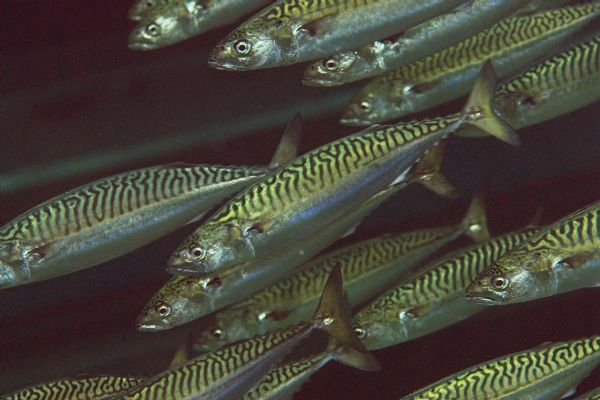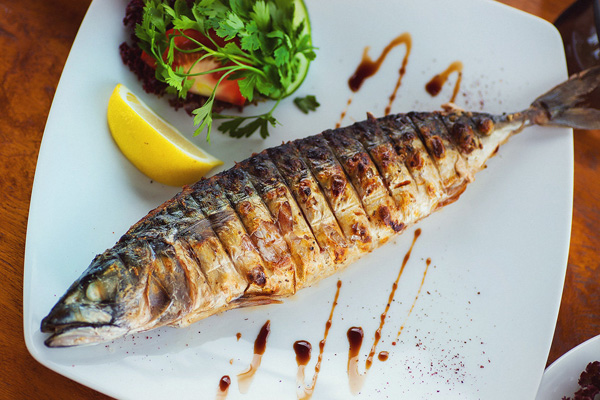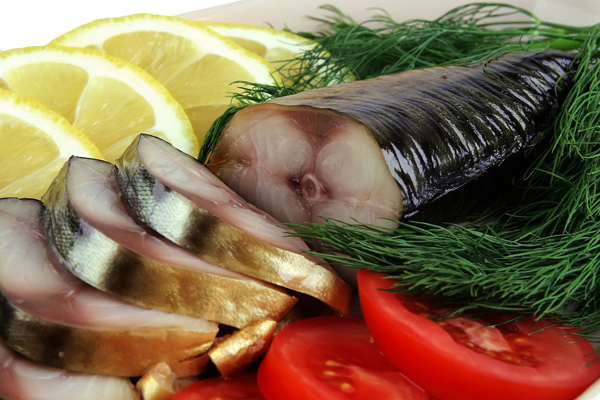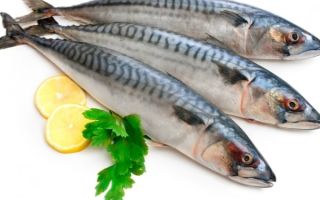Content
- 1 What is this fish
- 2 The chemical composition of mackerel
- 3 How many calories are in mackerel
- 4 Useful properties of mackerel
- 5 Is it possible for children to mackerel
- 6 Slimming mackerel
- 7 Is mackerel possible for diabetes, gastritis and pancreatitis
- 8 Do they eat mackerel caviar
- 9 The benefits and harms of smoked mackerel
- 10 Is salted and pickled mackerel good for you?
- 11 How to cook mackerel
- 12 Mackerel harm and contraindications
- 13 How to choose the right mackerel
- 14 How to store mackerel
- 15 Conclusion
- 16 Fish reviews
Mackerel is a valuable commercial fish of the mackerel family. All its representatives belong to the commercial species. The second name for mackerel is mackerel. This fish is often found on store shelves. Should you buy it? What are the benefits and harms of mackerel? What to cook from it? These questions often concern consumers.
What is this fish
The mackerel has an elongated shape. The head tapers towards the mouth. The tail is thin, 6 cm long. The widest place between the back and belly is no more than 30 cm. A standard fish has parameters: 60 cm in length and 12 cm in width. Mackerel is painted gray with a silvery sheen. On the bluish back, it has transverse dark stripes.
The fish has a wide habitat in the world's oceans. The species that live in different places differ in size and color:
- The African species lives in the central and eastern parts of the Atlantic Ocean and the seas belonging to its basin. The species is found in the southern part of the Black Sea. Warm waters and good food supply allow the fish to grow to their maximum size.
- The habitat of the Japanese species is the Pacific Ocean from Japan to Australia. Shoals of fish enter the Indian Ocean. This is the smallest species - the weight does not exceed 350 g. One of the differences is the specific blue color.
- Australian mackerel is found in the Indian and Pacific Oceans. A distinctive feature is a greenish back with a bluish tint with a silvery-white belly. The stripes on the back are preserved, but have an intermittent structure.
- The Atlantic species inhabits the northern part of the Atlantic Basin. In summer, it goes far north, up to the Barents Sea. She has a white abdomen and no swim bladder. This is the main commercial species of Russian fishermen.

The chemical composition of mackerel
The chemical composition of mackerel is based on proteins and fats. There are absolutely no carbohydrates in it. But there is ash - a natural adsorbent that helps cleanse the human body. The fish is fatty: it contains about 21% fat. This is due to the content of 75 mg of cholesterol per 100 g of weight. This weight accounts for 23, 85 g of proteins - this is 32% of the norm for an adult per day.
The composition is distinguished by a large number of amino acids. These substances (there are 14 of them in the chemical composition of fish) play an important role in the human body:
- ensure the normal development of the body;
- are the basis for protein reproduction;
- take part in providing cells with oxygen;
- stimulate metabolic processes;
- improve the condition of nerve cells.
Some amino acids enter the human body only with food. All of them are included in mackerel.
How many calories are in mackerel
The calorie content of mackerel per 100 grams is 262kcal. This figure applies to fresh fish. In culinary performances, the calorie content depends on the cooking method.
|
Cooking method |
Calorie content per 100 g of weight |
|
Baked |
194 kcal |
|
Hot smoking |
317 kcal |
|
Cold smoking |
150 kcal |
|
Salty |
194 kcal |
|
Fried |
257 kcal |
|
Boiled |
211 kcal |
Useful properties of mackerel
Thanks to a wide range of useful substances, this fish has a beneficial effect on the human body:
- supports human immune forces;
- reduces the risk of neoplasms, helps in the fight against cancer;
- improves vision;
- stimulates metabolism;
- regulates hormonal levels;
- has an analgesic effect, helps to reduce headaches and joint pain;
- inhibits the formation of cholesterol deposits in blood vessels;
- helps to improve blood circulation;
- improves memory;
- removes toxic elements from the body;
- prevents atherosclerosis.

Benefits of mackerel for women
This fish is especially useful for the female body. Women's oncology is becoming the scourge of our time. The amino acids in mackerel (Omega-3 and Omega-6) help to strengthen the immune system and prevent cancerous growths. The benefits of vitamin D have been known for a long time. It participates in the formation of bone tissue, normalizes mineral metabolism, and improves overall well-being.
Vitamin B12 (cobalamin) keeps iron in the blood cells, preventing iron deficiency. Vitamin E is called the female vitamin. It participates in the formation of collagen and elastin. Women who have a sufficient amount of this vitamin in their bodies can be seen from afar. Their skin is radiant with youth and freshness.
Mackerel during pregnancy and breastfeeding
Fresh mackerel is very beneficial for pregnant women. The amino acids included in its composition help the fetus to develop correctly, prevent rickets. Vitamin D contributes to the development of muscles and bones during intrauterine growth. Vitamin E controls the correct development of the infant's nervous system. Omega-3 and Omega-6 acids are the full-fledged formation of brain tissue and the body's resistance to external influences.
The minerals contained in this fish provide undeniable benefits:
- phosphorus strengthens bone tissue;
- zinc supports the formation of leukocytes, participates in strengthening the protective functions of the body;
- potassium stimulates cardiac activity;
- manganese suppresses free radicals, supports blood clotting;
- selenium increases the body's resistance to viruses and bacteria.
Pregnant women should eat boiled mackerel more often. Can be baked in the oven with vegetables. Smoked mackerel will not harm pregnant women either.
Mackerel will bring undeniable benefits to a nursing mother. All the nutrients that this product is rich in will enter the baby's body with mother's milk.

Why mackerel is useful for men
This fish is especially valuable for men due to minerals such as selenium and zinc. These elements are involved in the formation of the male hormone testosterone. Omega acids stimulate potency and have a beneficial effect on procreation.
Is it possible for children to mackerel
Seafood dishes are easy to digest, so they can be used in baby food. But remember that mackerel is a fatty fish. The child's body reaches the normal formation of the digestive system only by the age of three. At what age can mackerel be given to a child? From the age of three. This product contains a lot of complete protein that is useful for the growth of the child's body.
Children need to cook mackerel separately. You should strive to choose foods that reduce the calorie content of fish and limit the amount of fat.
The use of mackerel is contraindicated in children when:
- they cannot tolerate fish oil,
- have diseases of the digestive or excretory system.
Slimming mackerel
You can't just think of losing weight as weight loss. It is the process of changing lifestyle and eating habits. To normalize weight, it is necessary to eat food that enriches the body with building materials. From this point of view, mackerel is beneficial for weight loss. The microelements contained in it enrich the body, normalize metabolic processes. Mackerel protein is well absorbed by humans.
You should pay attention to how mackerel is used in a diet. Only fresh or frozen fish retains all the best qualities. If the fish is first thawed and then frozen again, then the nutritional value of the product drops dramatically. Healthy fats break down and become harmful.
Is mackerel possible for diabetes, gastritis and pancreatitis
One of the main rules for the use of fish by patients suffering from diabetes, gastritis and pancreatitis is that the fish must live in cold waters. From this point of view, the Atlantic variety is simply a storehouse of health. There are several restrictions that will allow people with gastrointestinal disorders to use mackerel:
- You cannot eat fish caught in the fall. Mackerel contains the highest amount of fat during this time of year.
- You should not eat salted and smoked fish.
Preference should be given to steamed, baked and boiled dishes.

Do they eat mackerel caviar
In fish carcasses on sale, no one has ever seen caviar. Banks don't have it either. Commercial catch of mackerel is not carried out in breeding areas. She manages to successfully sweep away eggs before she is caught. This is very good: the volume of industrial catch grows from year to year, but this does not affect the amount of fish. But what the mackerel caviar tastes like, is it possible to eat it - this is not given to the broad masses of consumers. People living in East Asia use mackerel caviar for food. They make pasta and other dishes from it.
The benefits and harms of smoked mackerel
The benefits of cold smoked mackerel are undeniable. When using it:
- digestion improves;
- metabolism is normalized;
- nerve cells are strengthened;
- hemoglobin rises;
- cholesterol is normalized;
- blood clots break;
- the process of cell reproduction improves;
- strengthens the immune system;
- improves memory.
The cold smoking process allows you to preserve all the useful vitamins and minerals.
Smoked mackerel has its own contraindications. When smoking, the calorie content increases. This is due to the limitation of its use. Another negative side of smoked mackerel is the absorption and preservation of carcinogenic substances.
The best way to cook smoked fish is with a simple smokehouse. The consumption of smoked mackerel is dangerous for people with diseases of the digestive system.

Is salted and pickled mackerel good for you?
During the salting process, mackerel retains a maximum of nutrients. The benefits of this fish are described. Attention should be paid to the problems that arise when using it:
- Salted mackerel should not be consumed by people with kidney disease. The diseased organ does not filter fluid well. Salt builds up in the bladder, irritating it and leading to inflammation.
- Acetic acid is used for pickling. Excess acids of any kind have a negative effect on people with digestive problems. They need an alkaline diet, so the pickled product should be discarded.
Lightly salted mackerel is the preferred and safest option.
How to cook mackerel
The word mackerel is a cold smoked fat fish with a golden back.But mackerel allows you to cook many healthier and more nutritious dishes:
- Baked mackerel is good for people who are overweight. It is delicious baked with vegetables. The easiest option for a light and nutritious dinner is mackerel baked in a sleeve with potatoes.
- The benefits of boiled mackerel are undeniable for people with disorders of the digestive system. The excess fat will remain in the broth. There is boiled mackerel well with potatoes. Rice will be an excellent side dish. A couple tablespoons of broth will help enhance the flavor of the side dish.
- Canned mackerel lasts longer. You shouldn't buy canned food. The fish is rolled into cans, and they are oxidized. You need to preserve yourself. Pieces of fish seasoned with spices are placed in a glass jar and placed in the oven. Cooking time at 200 ֯ C is 2 hours. It turns out mackerel in its own juice. This cooking method preserves all the properties of fresh fish. Homemade canned food is stored in the refrigerator for a long time. They are used as an independent dish. Diet salads with canned mackerel are excellent. Fish soups are prepared on its basis.
Mackerel harm and contraindications
The biggest problem with mackerel is its ability to accumulate substances harmful to humans. This is especially true for mercury. Fatty smoked fish is an unacceptable product for patients with gastrointestinal diseases.
Marinated mackerel should not be eaten by patients suffering from pancreatitis. People who have kidney pain should give up salted fish. The negative moments associated with the use of this healthy product can be easily avoided if you choose the right cooking method.
How to choose the right mackerel
You should always choose only fresh fish. This is evidenced by:
- clean, not clouded eyes;
- shiny, not matte skin;
- dense consistency without dents;
- elastic, not spreading gills.
A good fillet has a moist sheen and a transparent consistency.
People who are contraindicated in oily fish should buy mackerel only in the spring. At this time of year, the fat content is low. Indicators of good quality smoked mackerel are golden skin, meat density, light smoke smell. If on the body of hot smoked fish there are prints from the net or the pallet, this is an indisputable proof of its quality. It suggests that the fish was naturally smoked.
Traces of the container are not related to cold smoked mackerel. It is smoked at the top of the smokehouse, tied by the tail. Strong odor is evidence of poor quality of the initial product. This is a common technique to hide flaws.

How to store mackerel
Eating fresh fish is optimal. Fresh unpeeled fish can be stored in the refrigerator for no more than 24 hours. If cooking is delayed, freezing is the best storage option.
Mackerel can be stored frozen for up to 90 days. Fish salted in brine is stored for up to 7 days at a temperature of 4 to 7 degrees Celsius. Hanging mackerel wrapped in waxed paper will retain nutritional value for 2 days without a refrigerator. In the refrigerator, this period will increase to a week. Pickled mackerel will keep in the refrigerator for up to 7 days. If onions are added to the marinade, the shelf life is reduced to 2 days.
Conclusion
Having dealt with the chemical composition, it becomes clear what the benefits and harms of mackerel are. Mackerel is a relatively cheap fish that is constantly present on store shelves. It allows you to prepare many varied and delicious dishes. Everyone is able to choose a suitable mackerel dish and receive undeniable benefits from its use.

